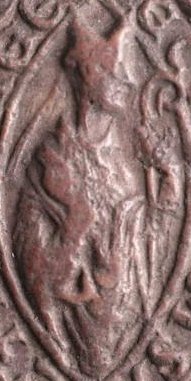William de Malveisin facts for kids
Quick facts for kids William de Malveisin |
|
|---|---|
| Bishop of St Andrews | |
 |
|
| Church | Roman Catholic Church |
| Diocese | St Andrews |
| In Office | 1202–1238 |
| Predecessor | Roger de Beaumont |
| Successor | David de Bernham |
| Orders | |
| Consecration | 24 September 1200 by Renaud de Forez |
| Personal details | |
| Born | France |
| Died | 9 July 1238 Inis Muiredaich |
| Previous post | Bishop of Glasgow |
William de Malveisin was an important church leader in Scotland. He was known as the Chancellor of Scotland, a key royal advisor. He served as Bishop of Glasgow from 1199 to 1202. After that, he became the Bishop of St. Andrews, a very high-ranking position, from 1202 until his death in 1238.
Template:TOC limit=3
Contents
Early Life and Career
William de Malveisin was likely born in France. His family probably came from the area around the lower Seine valley. He might have been the nephew of Samson de Malveisin, who was an Archbishop of Rheims. This family connection likely helped him start his career in the church.
Joining the Scottish Royal Court
William first appears in Scottish records in the 1180s. He worked as a royal clerk, which meant he helped the king with official documents. By 1193, his hard work earned him his first church role. He became the Archdeacon of Lothian.
Becoming a Bishop
William was made the king's Chancellor around September 1199. In October of the same year, he was chosen to be the Bishop of Glasgow. He was officially made a bishop in September 1200 in Lyon, France. This ceremony was led by Renaud de Forez, the Archbishop of Lyon.
Just two years later, in September 1202, William moved to an even more important role. He became the Bishop of St. Andrews. This was a higher-ranking position in the church.
A Small Challenge
William faced a small issue when he started his new role. He began using his bishop's powers before the Pope had officially approved his appointment. One of his church officials, Eustace, raised a concern about this. A church official sent by the Pope, John of Salerno, heard the case. He held a meeting in Perth in December 1201. However, nothing serious came from this concern.
Bishop of St. Andrews
As Bishop of St. Andrews, William worked to make the bishopric stronger. He wanted to increase its influence and land.
Expanding Church Influence
When Gille Ísu, a local priest in Wedale, passed away, William saw an opportunity. He brought the church in Wedale under the control of his diocese. This helped expand the power of the Bishopric of St. Andrews.
Working with the Céli Dé
Bishop William had good relationships with a group of native Scottish clergy. They were known as the "Céli Dé," which means "Vassals of God" in Gaelic. The Pope had previously excommunicated, or removed from the church, the Céli Dé. However, William worked to help them.
Between 1206 and 1216, and again in 1220, he managed to get the Pope to forgive the Céli Dé. This helped them return to good standing with the church. William's support also encouraged the Céli Dé to work more closely with the Pope. It also allowed non-native clergy, like Henry de Weles, to serve in their church, the Church of St Mary on the Rock at St. Andrews.
Travel and Later Life
According to a writer named Walter Bower, William received permission from King William to visit his family in France. This trip might have happened between May 1212 and spring 1213. During this time, Bishop William's name does not appear in official records.
Possible Author of Arthurian Romance
Some historians, like D.D.R. Owen, believe that William de Malveisin might have been more than just a bishop. They suggest he could have been an author of Arthurian romance. The writer of a story called the Roman de Fergus identified himself as Guillaume le Clerc, or William the Clerk. Owen argues that William de Malveisin is a strong candidate for being this author.
Death
Bishop William de Malveisin passed away in 1238. He died at a place called "Inchemordauch," which was one of the Bishopric's properties. His death likely occurred on July 9th. The next person to become Bishop of St. Andrews was David de Bernham.
Images for kids


